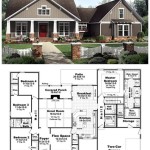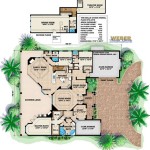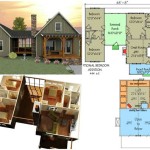A floor plan, also known as a plan view, is a schematic diagram that illustrates the room layout of a building, typically referring to a particular level of it. This 2D representation is an essential blueprint for visualizing the arrangement of walls, rooms, corridors, and other architectural elements within a house.
Having access to a floor plan of your house can be valuable for various reasons. During home renovations or remodeling projects, it can serve as a blueprint for planning and executing changes to the layout. It can assist in accurately measuring room dimensions for furniture placement, ensuring that everything fits harmoniously within the available space.
In the following sections, we will delve into the methods of locating floor plans for your house using both online and offline resources. We’ll explore how to effectively search and request these plans, ensuring that you have the necessary information to make informed decisions about your home.
Finding floor plans for your house can be a valuable step in understanding your home’s layout and making informed decisions about renovations or remodeling. Here are ten important points to consider when searching for your house’s floor plans:
- Contact the Architect or Builder:
- Check Local Building Department:
- Utilize Online Resources:
- Search Property Records:
- Inquire with Previous Owners:
- Explore Homeowner Associations:
- Consider Hiring a Professional:
- Utilize Floor Plan Software:
- Document Any Changes Made:
- Maintain Copies for Future Reference:
By following these steps, you increase your chances of locating the floor plans for your house, empowering you with the necessary information to plan and execute modifications or simply gain a deeper understanding of your home’s structure.
Contact the Architect or Builder:
If you have the fortune of knowing the architect or builder who designed and constructed your house, reaching out to them can be a direct and effective approach to acquiring floor plans. Architects and builders often maintain copies of their work, including floor plans, as part of their professional records.
- Request a Copy:
Contact the architect or builder and inquire if they have a copy of the floor plans for your house. Explain your need for the plans and how you intend to use them.
- Be Polite and Respectful:
Remember that these professionals may be busy, so be polite and respectful of their time. Understand that they may not always have the plans readily available or may charge a fee for providing them.
- Provide Necessary Information:
When reaching out, provide as much information as possible about your house, such as the address, year of construction, and any unique features that may help them locate the plans.
- Explore Alternative Options:
If the architect or builder is unable to provide the floor plans, they may be able to suggest alternative sources or professionals who can assist you in finding them.
Approaching the architect or builder is a valuable step in your search for floor plans, as they possess firsthand knowledge and documentation related to your house’s design and construction.
Check Local Building Department:
The local building department is a valuable resource for obtaining floor plans, particularly if your house is relatively new or if you reside in a region where building permits and inspections are mandatory. Building departments typically maintain archives of approved building plans, including floor plans, for all structures within their jurisdiction.
- Inquire in Person:
Visit the local building department and inquire about the availability of floor plans for your house. You may need to provide the address, year of construction, or other identifying information.
- Submit a Formal Request:
Some building departments require a formal request in writing or through an online portal. Follow the established procedures and provide any necessary documentation to initiate the request.
- Pay Associated Fees:
There may be associated fees for obtaining copies of floor plans. Inquire about the charges and be prepared to pay the required amount.
- Review and Collect:
Once your request is processed, review the floor plans carefully to ensure accuracy. You may need to make an appointment to collect the plans or have them mailed to you.
Checking with the local building department offers a reliable and official source for floor plans, providing you with peace of mind knowing that you have the most up-to-date and approved plans for your house.
Utilize Online Resources:
The internet offers a wealth of resources for finding floor plans. Numerous websites and platforms provide access to extensive databases of floor plans, allowing you to search and download plans for houses, apartments, and other types of buildings.
- Floor Plan Websites:
Dedicated floor plan websites offer a vast collection of plans for residential and commercial buildings. These websites often allow you to filter your search by style, size, and other criteria to find plans that meet your specific requirements.
- Real Estate Websites:
Many real estate websites, such as Zillow and Trulia, provide floor plans for the properties they list. If you are interested in a particular house for sale or rent, you may be able to access its floor plan through the website’s listing.
- Manufacturer Websites:
If you live in a prefabricated or manufactured home, the manufacturer’s website may provide access to floor plans for your model. These plans can be helpful for understanding the layout and making any necessary modifications.
- Social Media Groups:
Joining social media groups dedicated to architecture, home design, or your local community can be a valuable way to connect with other homeowners and professionals who may have access to floor plans or know where to find them.
Utilizing online resources can greatly expand your search options and provide you with a convenient way to access floor plans from the comfort of your own home.
Search Property Records:
Property records, often maintained by county or city offices, can be a valuable source of floor plans, particularly for older houses or those in areas with well-established record-keeping systems.
These records may include original building permits, which often contain detailed floor plans submitted as part of the construction process. Additionally, some jurisdictions may have digitized these records, making them accessible online through public databases or county websites.
To search property records for your house’s floor plans, you will typically need to visit the relevant government office in person or access their online portal. You may need to provide the property address, year of construction, or other identifying information to locate the records.
Once you have identified the relevant records, carefully review the available documents for floor plans or related drawings. These plans may be included as part of the building permit application or in separate files. It is important to note that not all property records will contain floor plans, especially for older houses or those in areas where record-keeping practices were less comprehensive.
Searching property records can be a time-consuming process, but it can be a rewarding one if you are able to locate the original floor plans for your house. These plans can provide valuable insights into the original design and layout of your home, as well as any modifications or additions that have been made over the years.
Inquire with Previous Owners:
If you are unable to locate floor plans through the previously mentioned methods, reaching out to previous owners of your house can be a worthwhile step. Former homeowners may have retained copies of the floor plans or may know where they can be found.
To find previous owners, you can start by searching public records, such as property deeds or tax records. These documents will typically list the names and contact information of previous owners. You can also try contacting your local title company or real estate agent, as they may have access to this information.
Once you have identified a previous owner, reach out to them politely and explain your need for the floor plans. Be clear about the address of the house and provide any other relevant details that may help them locate the plans. Offer to compensate them for any expenses they may incur in providing the plans.
Even if the previous owner does not have the floor plans readily available, they may be able to provide valuable information about where you can find them. They may have stored the plans in a specific location, such as a basement or attic, or they may know of a family member or friend who has a copy. By maintaining a polite and respectful demeanor, you increase the chances of previous owners being cooperative and providing assistance in your search for the floor plans.
Inquiring with previous owners can be a valuable step in your search for floor plans, as they may have retained copies or know where they can be found. By approaching them politely and respectfully, you can increase the likelihood of obtaining the necessary information to locate the floor plans for your house.
Explore Homeowner Associations:
If your house is part of a homeowners association (HOA), reaching out to the HOA can be a valuable step in your search for floor plans. HOAs often maintain records and documentation related to the properties within their jurisdiction, including floor plans.
- HOA Records:
HOAs may have access to original floor plans or blueprints that were submitted as part of the development or construction process. These plans can provide detailed information about the layout, dimensions, and features of your house.
- Contact HOA Management:
The HOA management office is typically responsible for maintaining and managing HOA records. Contact the management office and inquire about the availability of floor plans for your house. They may be able to provide you with copies or direct you to the appropriate source.
- HOA Website and Portal:
Some HOAs have online websites or portals where residents can access community documents and resources. Check the HOA website or portal to see if floor plans are available for download or if there is a process to request them.
- Community Directory:
The HOA may have a community directory that lists the names and contact information of residents. If you are unable to obtain floor plans from the HOA management, you can try reaching out to other homeowners in your community. They may have copies of the floor plans or know where you can find them.
Exploring homeowner associations can be a valuable step in your search for floor plans, especially if your house is part of a planned development or community. By contacting the HOA management, checking the HOA website or portal, and networking with other homeowners, you increase your chances of locating the floor plans for your house.
Consider Hiring a Professional:
In certain situations, hiring a professional can be a valuable option for finding floor plans for your house. Professionals such as architects, engineers, or licensed contractors may have access to floor plans or be able to create them based on your specific needs.
- Expertise and Knowledge:
Professionals have the necessary expertise and knowledge to accurately measure and draft floor plans. They can provide detailed and precise plans that meet industry standards and building codes.
- Access to Resources:
Professionals may have access to resources and databases that contain floor plans for various types of houses. They can leverage these resources to locate plans that closely match your house’s layout and design.
- Custom Floor Plans:
If your house has unique features or modifications, a professional can create custom floor plans that accurately reflect the current layout. This is especially useful for older houses or those that have undergone significant renovations.
- Legal and Insurance Implications:
Hiring a licensed professional to create floor plans can provide legal protection and insurance coverage in case of any errors or disputes related to the accuracy of the plans.
While hiring a professional may involve additional costs, it can provide peace of mind and ensure that you have accurate and reliable floor plans for your house. Professionals can also offer valuable insights and recommendations based on their experience and knowledge of building design and construction.
Utilize Floor Plan Software:
Floor plan software offers a convenient and accessible way to create or modify floor plans for your house. These software programs provide a user-friendly interface and a range of tools that allow you to design and customize floor plans according to your specific requirements.
With floor plan software, you can easily create detailed floor plans by dragging and dropping walls, doors, and windows. You can adjust the dimensions, add furniture and fixtures, and experiment with different layouts to visualize the space and make informed decisions.
Floor plan software often includes libraries of pre-designed floor plans and symbols, making it easy to create professional-looking plans. These libraries can include a wide range of elements, such as furniture, appliances, and architectural features, allowing you to quickly and accurately design your house’s layout.
Some floor plan software programs also offer advanced features such as 3D visualization, virtual walkthroughs, and compatibility with building information modeling (BIM) software. These features can provide a comprehensive understanding of your house’s design and help you make informed decisions during the planning and construction process.
Utilizing floor plan software can be a valuable option for creating or modifying floor plans for your house. These software programs offer a range of tools, features, and libraries that make it easy to design and customize floor plans according to your specific needs and preferences.
Document Any Changes Made:
As you make changes to your house, it is crucial to document these modifications accurately. Maintaining up-to-date floor plans that reflect the current layout of your house is essential for several reasons.
- Accurate Representation:
Documented changes ensure that your floor plans accurately represent the current state of your house. This is particularly important for future reference, renovations, or in case of an emergency.
- Legal and Insurance Purposes:
Having documented floor plans can be valuable for legal and insurance purposes. In the event of a dispute or insurance claim, accurate floor plans can provide evidence of the house’s layout and any modifications made.
- Future Renovations:
When planning future renovations or additions to your house, having up-to-date floor plans is essential. These plans serve as a baseline for design and planning, helping you visualize the impact of changes and make informed decisions.
- Safety and Emergency Preparedness:
Documented floor plans can also be useful for safety and emergency preparedness. They provide a clear understanding of the house’s layout, including the location of exits, rooms, and potential hazards, which can be invaluable in case of an emergency.
Documenting changes to your house’s floor plans is a simple but essential practice that can provide numerous benefits. By maintaining accurate and up-to-date plans, you ensure that your house’s layout is accurately represented, facilitate future renovations, and enhance safety and emergency preparedness.
Maintain Copies for Future Reference:
Maintaining copies of your house’s floor plans is essential for future reference. Having readily accessible plans can be invaluable in a variety of situations, such as planning renovations or repairs, resolving property disputes, or providing documentation for insurance purposes.
By keeping copies of your floor plans in both physical and digital formats, you ensure that you have a backup in case one version is lost or damaged. Physical copies can be stored in a fireproof safe or off-site location, while digital copies can be saved on your computer, external hard drive, or cloud storage service.
When making changes to your house, be sure to update your floor plans accordingly. This will help you maintain an accurate record of your house’s layout and any modifications made over time. It is also advisable to periodically review your floor plans and make any necessary revisions to ensure they remain up-to-date.
Having well-maintained and easily accessible floor plans can provide peace of mind and make it easier to navigate future projects or unforeseen events related to your house. By taking the time to maintain copies for future reference, you ensure that you have the necessary documentation to make informed decisions and protect your property.
Maintaining copies of your house’s floor plans is a simple but essential practice that can provide numerous benefits. By keeping both physical and digital copies in secure locations, updating your plans as changes are made, and periodically reviewing their accuracy, you ensure that you have the necessary documentation to support your decision-making and protect your property interests.





:max_bytes(150000):strip_icc()/floorplan-138720186-crop2-58a876a55f9b58a3c99f3d35.jpg)




Related Posts








